15 May, 2023
Welcome to this week’s JMP Report
Last week we saw 4 stocks trading on our local exchange, BSP, KSL, CCP and CPL. BSP traded 359,507 shares, closing unchanged at K12.90, KSL saw 446,265 trading 28t lower, closing at K2.20, CCP traded 38,838 shares, closing unchanged at K2.00 and CPL traded 38,500 shares closing unchanged at K0.80.
Refer details below;
WEEKLY MARKET REPORT | 7 May, 2023 – 11 May, 2023
| STOCK | QUANTITY | CLOSING PRICE | CHANGE | % CHANGE | 2021 FINAL DIV | 2021 INTERIM | YIELD % | EX-DATE | RECORD DATE | PAYMENT DATE | DRP | MARKET CAP |
| BSP | 359,507 | 12.90 | – | 0.00 | K1.4000 | – | 13.53 | THUR 9 MAR 2023 | FRI 10 MAR 2023 | FRI 21 APR 2023 | NO | 5,317,971,001 |
| KSL | 446,265 | 2.20 | –0.28 | -12.73 | K0.1610 | – | 9.93 | FRI 3 MAR 2023 | MON 6 MAR 2023 | TUE 11 APR 2023 | NO | 64,817,259 |
| STO | 0 | 19.10 | – | 0.00 | K0.5310 | – | 2.96 | MON 27 FEB 2023 | TUE 28 FEB 2023 | WED 29 MAR 2023 | YES | – |
| KAM | 0 | 0.95 | – | 0.00 | – | – | – | – | – | – | YES | 49,891,306 |
| NCM | 61 | 75.00 | – | 0.00 | USD$1.23 | – | – | FRI 24 FEB 2023 | MON 27 FEB 23 | THU 30 MAR 23 | YES | 33,774,150 |
| NGP | 0 | 0.69 | – | 0.00 | – | – | – | – | – | – | – | 32,123,490 |
| CCP | 38,838 | 2.00 | – | 0.00 | K0.225 | – | 6.19 | FRI 24 MAR 2023 | WED 29 MAR 2023 | FRI 5 MAY 2023 | YES | 569,672,964 |
| CPL | 38,500 | 0.80 | – | -18.75 | K0.05 | – |
4.20 |
WED 22 MAR 2023 | THUR 30 MAR 2023 | THU 30 JUL 2023 | – | 195,964,015 |
Our order book has us nett buyers of BSP, CCP, KSL and STO
Dual Listed Stock PNGX/ASX
BFL – 4.80 +2c
KSL – 76c +2c
NCM – 28.25 -1.55
STO – 7.12 -4c
Interest rates
An interesting TBill result. But firstly, in the Central Bank Bill market rates (this is where the Central Bank manages liquidity in the system), the rates have been slowly moving out with the gap between CBB and TBill narrowing. We understand that this is current Monetary Policy. Now we look to this week’s TBill result with only 365day TBills issued at 3.05%, with 195mill on offer and the Bank issuing only 145mill after receiving 450mill in bids. And then we see another GIS announcement on Friday evening with 50mill in each of the maturities on offer for auction this week. I guess we are seeing as much issued at these lower rates before they get pushed out. Maybe. I will bring you the GIS auction results in next week’s report.
And in other markets
Gold – 2011
Oil – 74.17
Bitcoin – 26917 -6.78%
Ethereum – 1800 -6.12%
PAXGold – 2016 -0.29%
What we’ve been reading this week
Four-Fifths of Board Members at America’s Top Six Banks are Climate Conflicted
By Rachel Sherrington
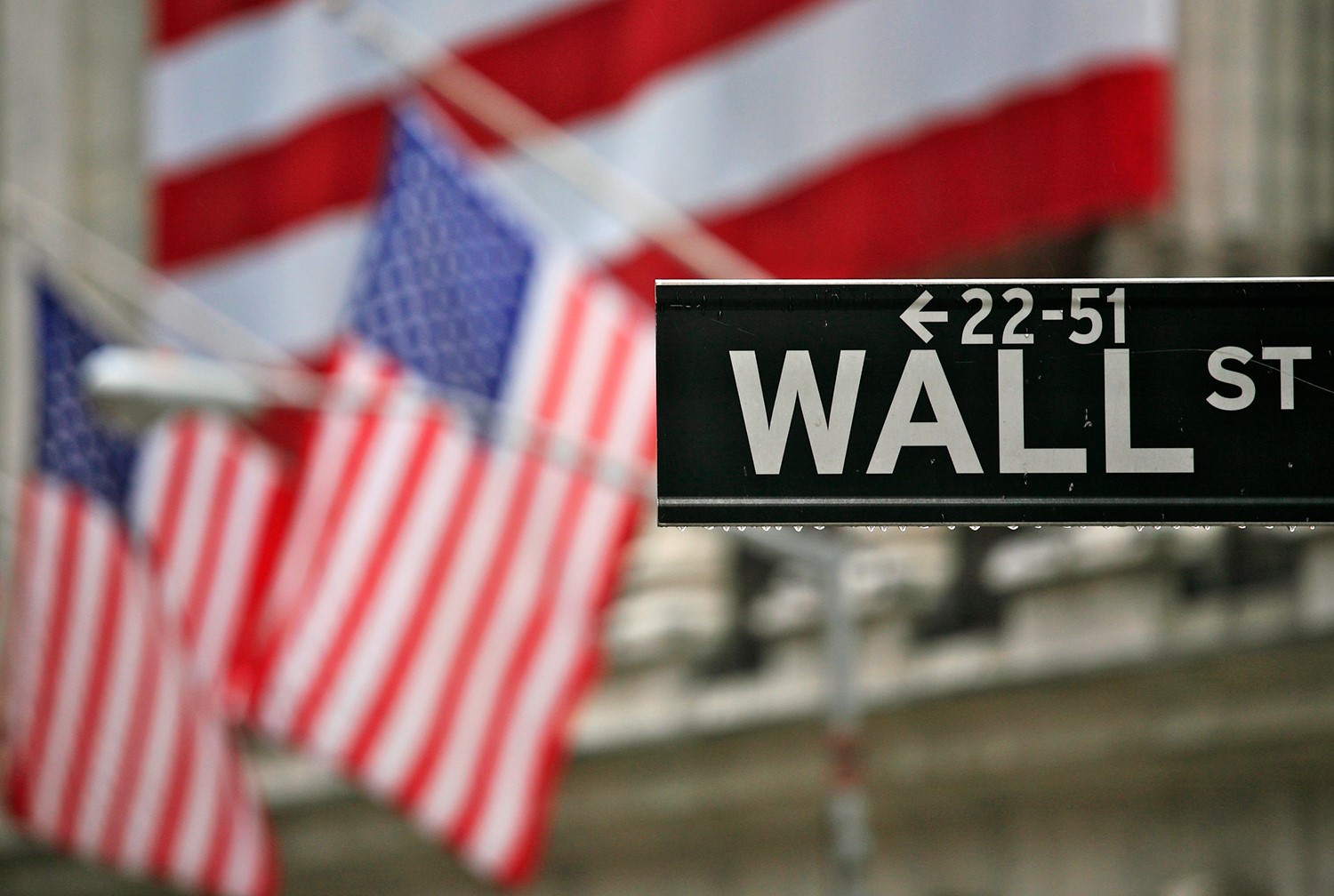
Wall Street, New York City. Credit: Alex Proimos / Flickr, CC BY-NC 2.0
Four in five bank directors at the six largest banks in the U.S. have ties to polluting companies and organizations, including major fossil fuel companies, according to a new DeSmog analysis.
The research raises fresh concerns about the extent of anti-environmental influence inside some of the nation’s most powerful boardrooms at a time when campaigners are pushing the banks to enact stronger environmental policies at their annual shareholder meetings.
It reveals that 82 percent of board members at these six banks currently hold or have held positions with climate-conflicted organizations. This includes oil and gas firms, investment companies that finance polluting sectors, and trade associations known to lobby against climate action.
Nearly one in five directors (19 percent) have current or past experience working in the fossil fuel industry.
The findings come as a March report from the head of the world’s leading climate science body, the Intergovernmental Panel on Climate Change (IPCC), said that big changes to finance were essential to avoiding catastrophic climate impacts.
Despite the increasing global attention paid to the climate crisis, the proportion of board members at these banks with climate conflicts has not changed in two years. The proportion of directors at the six banks linked to the fossil fuel industry remained the same as in 2021 – despite a number of changes at the top of these companies – as did the number of directors linked to other high-carbon industries.
Nearly one third of the board members at Bank of America, Citi, Goldman Sachs, JP Morgan Chase, Morgan Stanley, and Wells Fargo have current or past connections with companies identified by the Climate Action 100+ (CA100+) initiative as among the globe’s top climate polluters.
Companies active in generating energy from coal, the world’s most polluting fuel source, have former or current employees inside boardrooms at Bank of America, Morgan Stanley, and Wells Fargo. Directors on four of the boards of the six biggest banks in the U.S. currently hold leadership positions in the fossil fuel industry through other board memberships.
All six banks have pledged to reach net zero across their portfolios. However, according to a recent report by Rainforest Action Network, they have collectively provided $1.7 trillion in fossil fuel financing since the Paris Agreement was signed in 2015 and $413 billion since 2021 – the year in which the International Energy Agency called for no new financing of oil, gas, and coal projects. This financing involves both direct lending and underwriting debt and equity issuances.
“They’re actually propping up the expansion of the fossil fuel industry.”
Caleb Schwartz, Rainforest Action Network
Bank of America and Wells Fargo declined to provide a response on the record. All the remaining banks and named directors did not respond to our requests for comment.
Banks and other high-emitting companies have been facing a record number of climate demands at their recent annual general meetings (AGMs), where investors have the opportunity to vote on strategic decisions affecting their firms.
At the shareholder meetings of Wells Fargo, Bank of America, Citi, and Goldman Sachs on April 25 and 26, climate resolutions received mixed support from investors. Those calling for more disclosure of climate plans drew support, while those calling for an outright end to new fossil fuel financing proved less popular.
Voting on board member appointments has also been taking place, with the four banks seeing all their chosen directors either elected for the first time or re-elected. The remaining two shareholder meetings will be held by Morgan Stanley on May 19, and JP Morgan on May 22. Campaigners are urging shareholders at these meetings – and in the future – to consider voting against individuals who may be holding up climate action.
Jessye Waxman, Senior Campaign Representative in the Sierra Club’s Fossil-Free Finance campaign, said: “Given the troubling connections of many board members, it’s no surprise the U.S. banking majors are so far behind on their climate goals – including by continuing unrestricted financing for fossil fuel clients that refuse to transition, and by failing to finance climate solutions at rates commensurate with their fair share.
“Prudent shareholders would be wise to consider how board composition may negatively impact a bank’s ability to deliver on its goals – and vote their proxies accordingly.”
Fossil Fuel Links
The boards of the six biggest U.S. banks have extensive ties to the fossil fuel sector, the industry most responsible for rising greenhouse gas emissions, DeSmog research shows.
Nearly one in five directors have current or past experience working in the fossil fuel industry, through roles at oil, gas, and polluting utility companies.
While some directors linked to the fossil fuel industry – such as former Mexican President Ernesto Zedillo, who was previously an advisor to European oil giant BP, and a board member at Citi – have left the banks since DeSmog’s last analysis in 2021, others with fossil fuel affiliations have replaced them.
This includes Goldman Sachs director Jessica Uhl, who is the former Chief Financial Officer of the European oil giant Shellwhere she worked for nearly two decades until leaving in March 2022.
Other directors with long-held ties to the fossil fuel industry include Theodore F. Craver, a current director at CA100+ utility company Duke Energy. Craver has held a number of prominent roles in the U.S. energy sector over a career spanning more than 20 years.
The bank with the highest share of directors tied to the fossil fuel industry is Bank of America, where a third of the board (four directors) have experience working in the fossil fuel sector through roles at oil, gas, and fossil fuel-reliant utility companies. A fifth of the board members at Wells Fargo, Morgan Stanley, and Goldman Sachs have past or current experience in the sector.
Caleb Schwartz, Research and Policy Analyst at Rainforest Action Network and one of the authors of a new report into fossil fuel financing, said it was “both shocking and not surprising to see the amount of overlap between the boards of the fossil fuel and banking industries.
“It’s shocking because these banks have all committed to climate action and to their so-called net zero plans to decarbonize, and there’s a lot of PR and public-facing rhetoric about climate action,” Schwartz said.
“But it’s not necessarily surprising because the data shows that these banks are not aligned with the climate targets that they should be and they’re not taking necessary action and they’re actually propping up the expansion of the fossil fuel industry.”
While voting on directors and climate resolutions has now finished for four of the banks, climate resolutions will be on the table at the shareholder meetings of JP Morgan and Morgan Stanley, which will take place on May 16 and 19.
Support for climate resolutions in finance and big business has been on the rise. Although only a small number of these resolutions usually succeed, there have been a number of successful, watershed investor revolts over climate change in recent years.
This includes a revolt two years ago by shareholders at oil giant ExxonMobil, which led to the unseating and replacement of three Exxon directors over climate leadership concerns. Efforts to remove directors have also been attempted at oil companies Marathon and ConocoPhillips in recent years.
‘Very Bad Business’
Experts say that a reliance on fossil fuels is also a poor financial strategy – one that is at risk of being exacerbated by the conflicts of interest displayed by these board members.
The prevalence of directors with experience in the fossil fuel industry presents a risk, according to Tom Sanzillo, director of Financial Analysis at the Institute for Energy Economics and Financial Analysis, and former Deputy Comptroller for the State of New York.
This is due in particular to the waning profits of the fossil fuel industry and the increased volatility of fossil fuel investments, he said.
“I see it fundamentally as really bad business to have a heavy concentration of an industry that – except for the period of the Ukrainian oil price increase – has lagged the market for a decade and lost share value over the long-term considerably,” Sanzillo said.
“Since January 1, they’ve been at, or near, last place in the stock market. Their private equity positions have deteriorated. They lack any kind of financial growth rationale. Why would you want a heavy concentration of people from that industry on the board of a bank? From a financial policy point of view it’s unsound,” he added. “Where the economy is going really requires a rethink of boards. And that rethink needs to look at what kind of board members do you need to go forward in an economy that’s changing.”
DeSmog’s analysis also looked at the makeup of the board committees advising directors on financial risks.
The research found that 69 percent of the board members on the risk committees of these banks have ties to polluting companies and industries, including 14 percent who have current or past links to the fossil fuel sector.
One in five (19 percent) board members at the six biggest banks in the U.S. have current or past experience working in the fossil fuel industry.
For example, on the Goldman Sachs risk committee, former Shell CFO Uhl is joined by Adebayo Ogunlesi, a current director of Kosmos Energy, a Texan deepwater oil exploration company.
Analysts are agreed that the transition away from fossil fuels – driven by the urgent need to slow global heating and the plummeting cost of renewables – poses large financial risks to banks and to the wider economy if not managed carefully.
Under this scenario, banks are exposed to ‘stranded assets’, whereby oil, gas, and coal assets could quickly lose their value due to new regulations put in place by governments.
Sanzillo told DeSmog that the prevalence of directors with affiliations to fossil fuels could “increase the willingness of the banks to absorb more risk.”
He added that the members of these risk committees “are in fact a material risk to the banks’ successful investment strategies.”
Waxman affirmed this point, saying: “failing to phase out clients with disproportionately high climate-related risks subjects the banks to heightened regulatory scrutiny and increased capital requirements, risk of litigation and heightened credit risk, and reputational damage on an order significant enough to confer material financial risk.”
High-Carbon Connections
DeSmog’s analysis included financial and investment institutions that finance the fossil fuel industry, firms operating in other high-carbon sectors such as road transport and heavy industry, and trade groups that have lobbied against climate action.
Nearly one third (32 percent) of board members at the six banks have held roles, often senior, at other banks that are among the largest financial supporters of the fossil fuel industry.
For example, Steven D. Black – now a board member of Wells Fargo – is former Vice Chair of JP Morgan, the world’s largest bank and the largest funder of fossil fuels globally, which has given $434 billion to oil, gas, and coal companies since the Paris Agreement was signed.
Nearly one third of the directors have links to Climate Action 100+ companies, including major U.S. polluters such as General Electric and General Motors. The research also recorded the links between directors and companies in other high–carbon and fossil fuel reliant sectors such as mining, shipping, and aviation.
Nearly a quarter of the directors at the banks are linked to trade associations and think tanks that have campaigned against climate action or are connected to the fossil fuel industry. This includes nearly a dozen directors who were previously or are currently members of the U.S. Business Roundtable – a group of senior business leaders that has pledged to support climate action but which recently opposed key measures in President Joe Biden’s Inflation Reduction Act.
The ties of bank directors to polluting industries are concerning, said Richard Brookes, director of Climate Finance at the environmental advocacy group Stand.earth, as are their links to trade groups.
“We’re in a crisis and we need to use all the tools at our disposal to be accelerating towards a clean energy and renewable-based economy and every time a trade association lobbies against an important piece of legislation or policy, like the Inflation Reduction Act, they’re effectively putting their foot on the brake and slowing us down when we need to be moving full speed ahead,” he said.
“The directors that are involved in groups that are lobbying against climate regulation and policy should be questioned. There needs to be alignment [on climate] across the board and it is the responsibility of those banks to make sure that they’re doing everything that they can.”
A seeming lack of impetus to address climate conflicts of interest within these banks echoes their lack of climate action more broadly, Schwartz said. “I would say that it parallels the relative inaction that banks have taken on their climate financing commitments since 2021. We need to see a lot more and a lot quicker.”
Apple: 2 Billion Reasons Buffett’s Favorite Company Just Changed The Game
This article was published on Dividend Kings on Wed, May 10th.
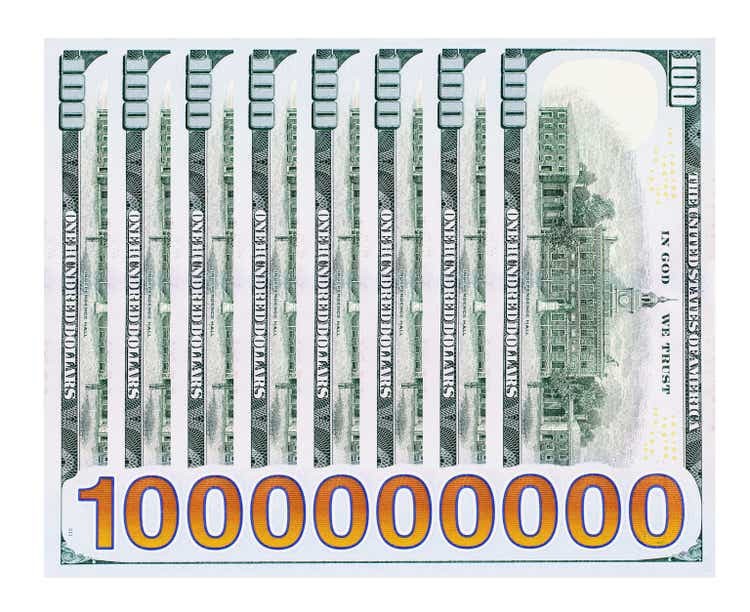
- Apple Inc. is the world’s favorite company and apparently (judging from his actions) Warren Buffett’s as well. Apple is now my favorite company, too.
- That’s because Apple has evolved from a tech company into a full-blown aspirational luxury brand.
- Apple recently scored two $1 billion luxury product launches, proving it can sell almost anything to steadily richer Millennials, Gen Z, and Gen Alpha consumers.
- Services, smart watches, smart speakers, payments, and smartphones… Apple has rapidly come to dominate nearly every product segment it targets.
- Apple could hit $50 billion in sales by 2030 with the Apple Car currently in-development, and then rapidly grow that into the hundreds of billions as it challenges Tesla for the ultimate aspirational auto brand. Luxury brands like LVMH have survived and thrived for over 100 years (up to 430 years). Apple’s 10% growth rate could last for decades, and it is the ultimate buy and hold forever Ultra SWAN.
Apple Inc. (NASDAQ:AAPL) is the world’s favorite company, the most valuable company on earth.
It’s also Buffett’s favorite company…by far.
It makes up almost 40% of Berkshire’s $300 billion portfolio.
Our criteria for Apple was different than the other businesses we own —It just happens to be better business than we own.” – Warren Buffett.
Why is a man who dislikes tech stocks willing to invest $116 billion of Berkshire’s money into Apple?
Buffett had a long-standing bias against technology investments, which he felt had no margin of safety.” – Washington Post.
Because Apple isn’t a tech stock, let me show you how its latest game-changing move proves it’s transformed into an aspirational luxury brand on par with LVMH Moët Hennessy (OTCPK:LVMHF, LVMHY).
One that has a bright future selling new products and services that we can only begin to imagine. For proof, I offer not one but two recent $1 billion luxury product launches for Apple.
$1 Billion In High-Yield Deposits In 4 Days Proves Apple Has Changed The Game
Apple recently launched a new high-yield savings account service tied to its credit card. Goldman Sachs is running the backend, and Apple is just the face of this new financial product.
In the first day, Apple’s high-yield account, which pays 4.15% interest, brought in $400 million in deposits. In the first four days, it brought in $1 billion.
How amazing is this? Here’s some context.
4.15% is a decent yield, but far from the best you can find in an FDIC-insured risk-free account.
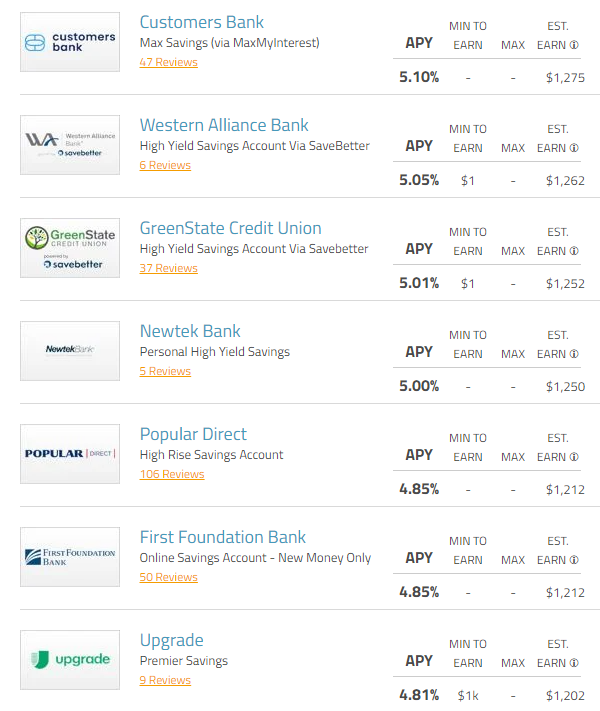
DirectSavings
Apple’s savings account offers about 1% less than the highest accounts in the country, but the power of Goldman Sachs (GS) backs it, and many people probably assume Apple and its $167 billion cash pile.
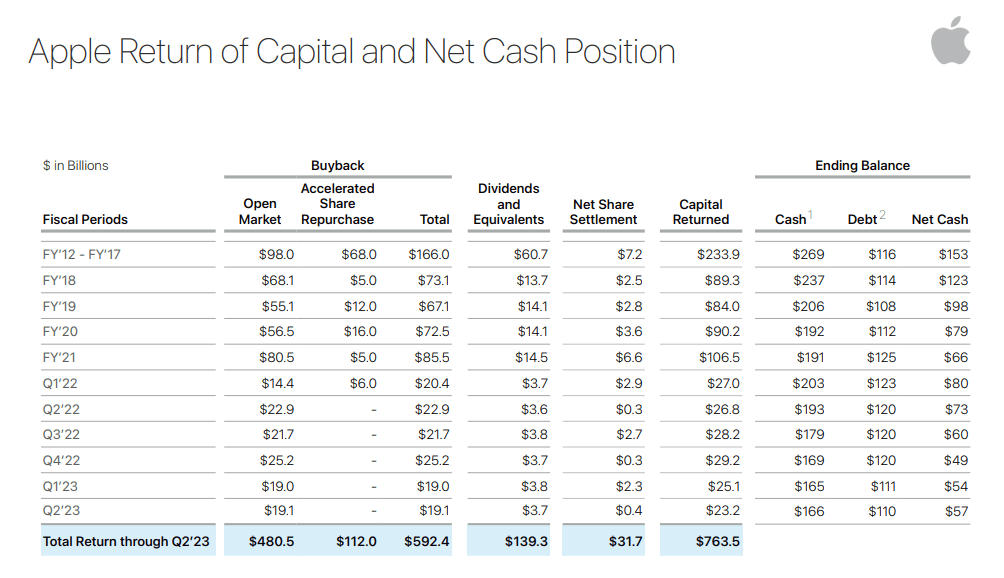
Apple
Apple has almost certainly continued to attract more deposits, but let’s go with $1 billion for now.
If Apple were a bank (it doesn’t want to be for regulatory reasons), it would be around the 800th bank in the country and likely the fastest growing.
Why am I so excited about Apple’s $1 billion in deposits in a high-yield savings account? It’s not because this is going to make Apple a lot of money.
This move is purely to make Apple Pay a stickier part of customers’ lives. It’s about building Apple’s ecosystem and making its brand even stronger.
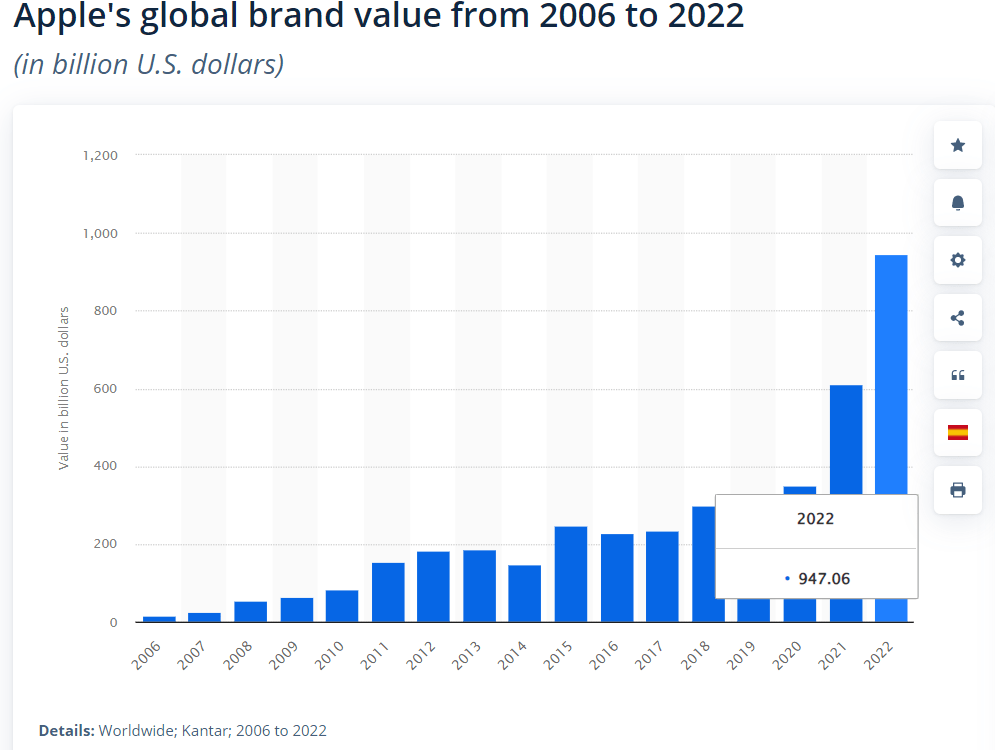
There is nothing more important to most corporate customers than their money. Being willing to park your cash in a savings account is an act of pure trust, especially in a regional banking crisis that is likely just entering phase 2 of 3.
Phases of the banking crisis:
- Bank runs (deposit flight)
- Negative profitability due to high funding costs (what is killing PACW)
- Loan losses in the recession (commercial real estate biggest threat).
Well, consumers trust Apple, and its brand has never been stronger.
Statista
That’s a brand that Statista estimates is worth almost $1 trillion all on its own.
If the Apple brand were a separate company, it would be the 6th most valuable on earth, ahead of Nvidia Corporation (NVDA) and right behind Amazon.com, Inc. (AMZN).
What does all this mean? How does the blowout success of a single new financial product change the game for Apple?
Apple Has Proven It’s A Luxury Lifestyle Brand
Apple has proven all bears and doubters wrong when it comes to new products and services.
When iTunes was launched, few thought it would lead to a subscription services business that is now $21 billion in a single quarter. That’s an annual revenue of $84 billion for a business that didn’t exist a few years ago.
Statista
Apple’s services business alone is larger than the sales of Coke (KO) and Netflix (NFLX) combined.
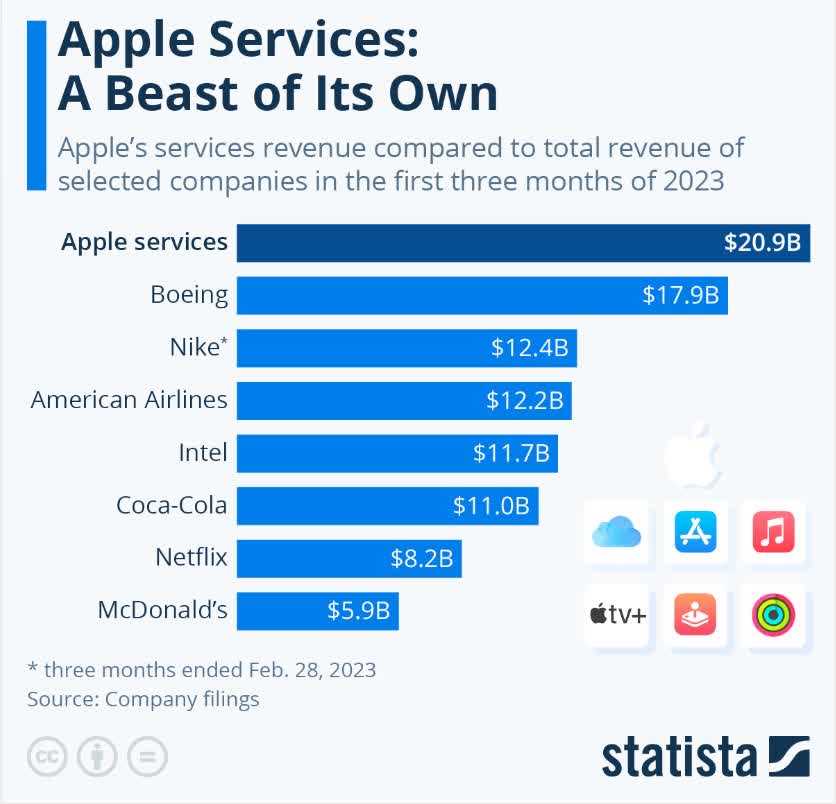
Statista
Services had gross margins of 71% in Q1 and are more stable than hardware sales.
And it’s now 21% of company sales and has been growing at 22% annually since 2013.

FactSet Research Terminal
Apple services are expected to grow to a $136 billion annual business by 2028, a 15% annual growth rate.
- 29% of company sales.
When AirPods were announced, I never imagined it could be a needle mover for Apple.
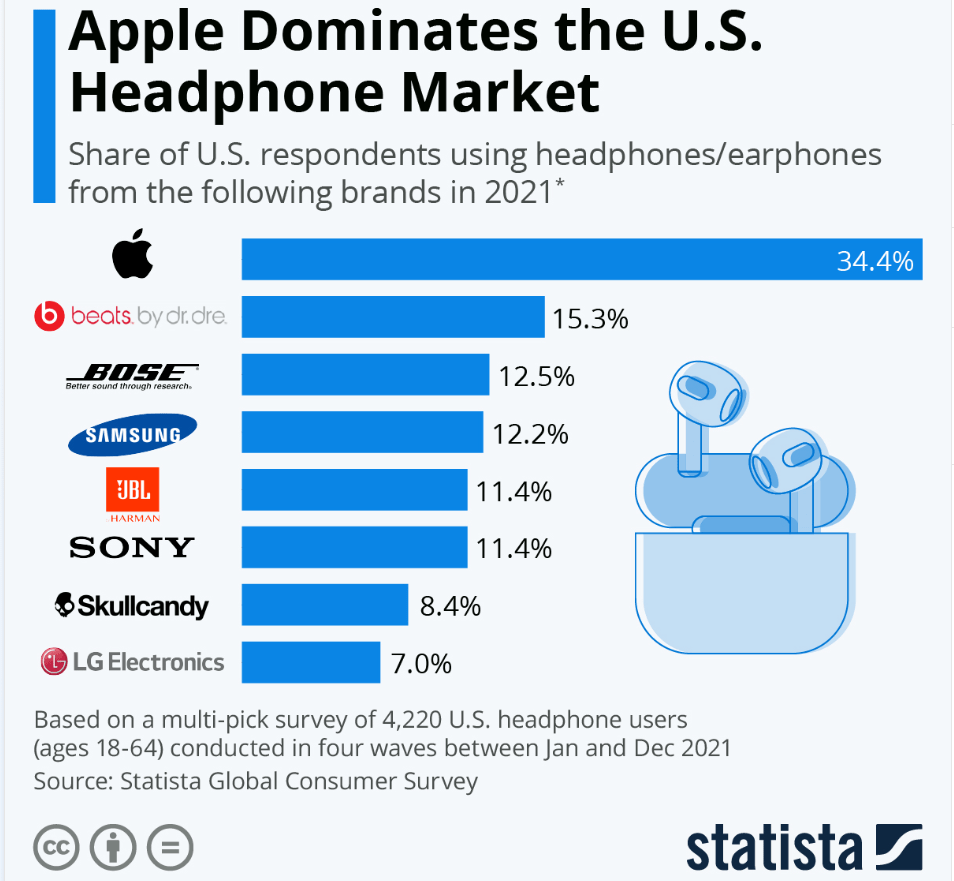
Statista
Apple controls 50% of the headphone market (it downs beats). The largest acquisition in Apple’s history was buying Beats for $3 billion in 2014.
These are expensive in-ear headphones costing $129 to $249. The AirPods Pro 2, which is $249, sold 4 million units in their first week.
- $1 billion in sales of a single product in one week
- almost as good as its high-yield savings account.
In Christmas 2022, Apple once more dominated the headphone space with 24 million units sold, 34% growth, and its market share grew 6%.
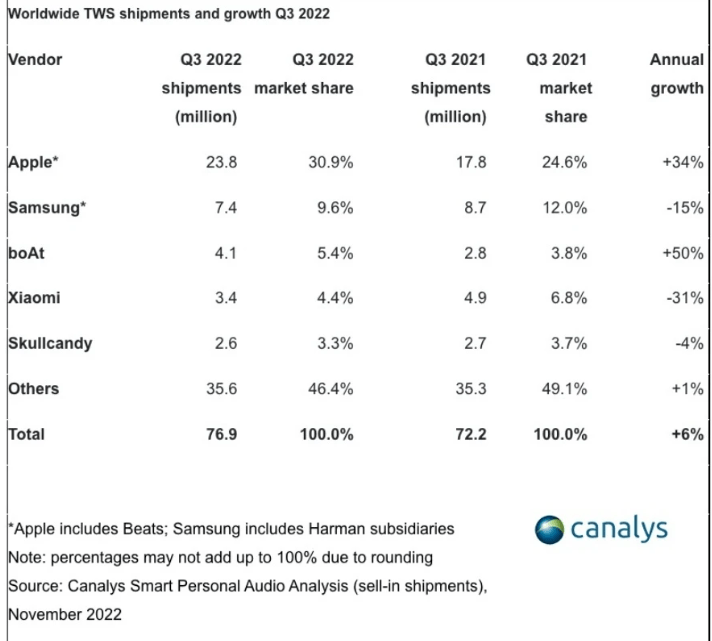 Canalys
Canalys
Samsung, the world’s 2nd biggest headphone company, has 1/3rd of Apple’s market share.
How about the Apple HomePod? I think smart speakers are nice but hardly “must-have” devices.
- My Amazon Echo only turns my lights on and off.
HomePod was introduced in 2018 and immediately gained a 6% global market share.
- Tied with Xiaomi (OTCPK:XIACF, OTCPK:XIACY) for 3rd.
By Q1 2022, Apple’s smart speaker global market share was 13%, second to Amazon’s 28% and Google’s 17%.
How about smartwatches? I own a Fitbit and personally think a computer on my wrist is overkill.
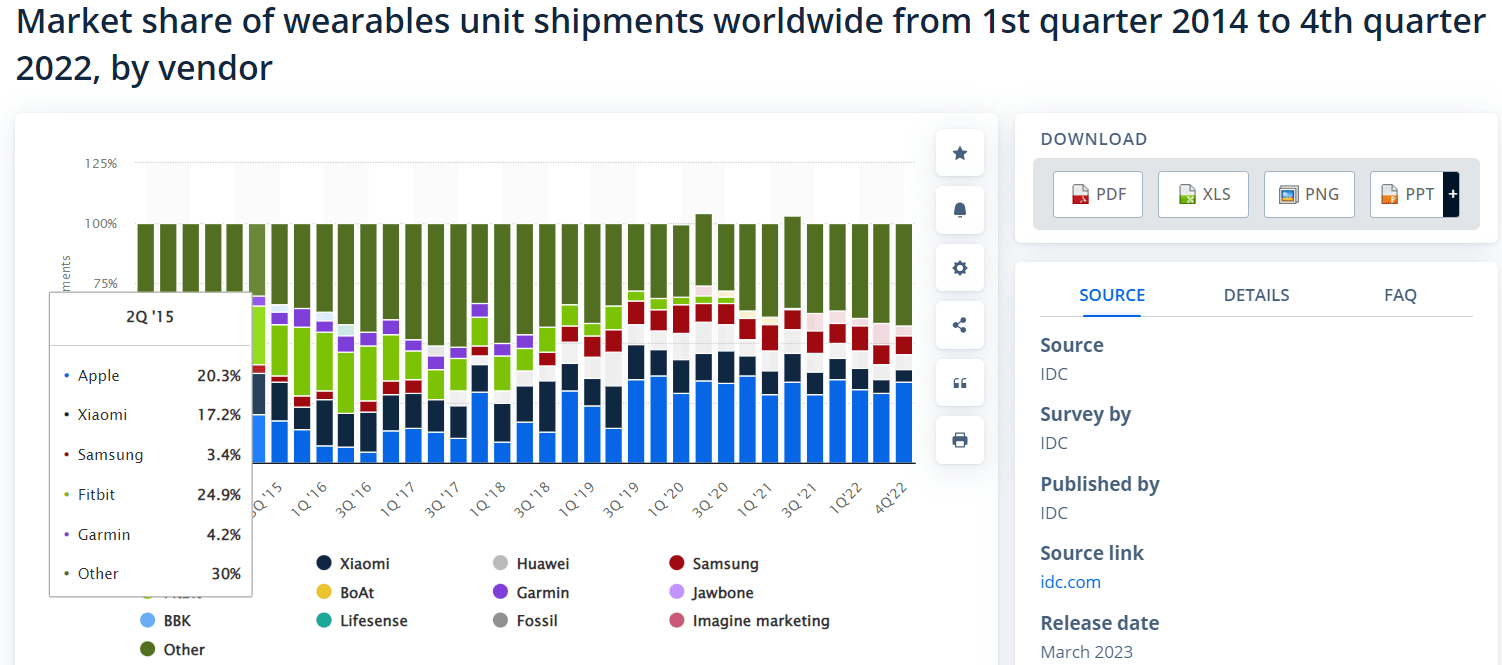 Statista
Statista
Mid-2015, Apple launches the Apple Watch. Skeptics don’t think it will move the needle. The company immediately captures a 20% market share and is #2 behind Fitbit.
Q4 2022 Apple commands 34% global smartwatch market share, 4X more than its nearest rival, Samsung Electronics Co., Ltd. (OTCPK:SSNLF).
 Statista
Statista
OK, so Apple has a habit of steadily growing market share and coming to dominate every product category it enters. But how much is it actually selling of these overpriced watches?
 Statista
Statista
Apple started out in 2013 with $6 billion in smartwatch sales.
Last year they sold $41 billion, a growth rate of 38% annually.
By 2026 analysts expect Apple to sell $77 billion worth of watches, a 17% annual growth rate.
And let’s not forget the most important business of all, the iPhone, which perfected the modern smartphone.
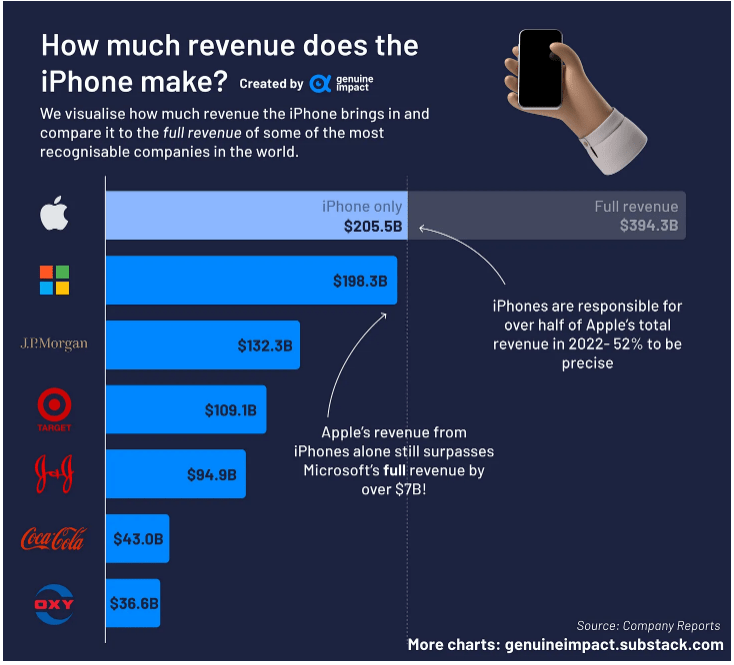 Genuine Impact
Genuine Impact
All on its own, iPhone sells more than all of Microsoft. In fact, it sells more than JPMorgan and Coke combined!
And thanks to its luxury lifestyle brand, fanatically loyal customers (94% of customers plan to stick with iOS), and an installed base of over 2 billion devices worldwide, Apple is the king of the only kind of phone share that matters, profit share.
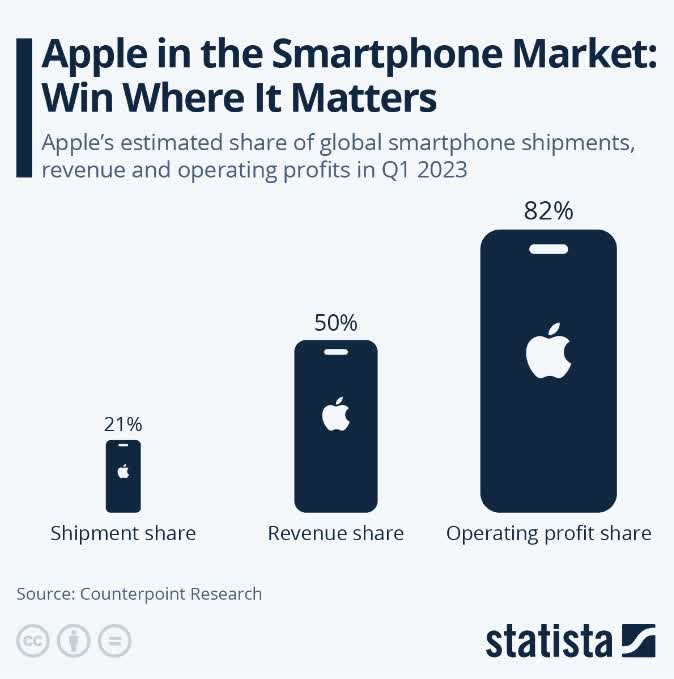 Statista
Statista
Apple earns 82% of smartphone operating profits and even more of its net profit.
Apple = The LVMH Of Young People
I have no interest in a Rolex, and most Millennials, Gen Z, and Gen Alphas don’t.
But Apple watches? Young people can’t get enough of these things!
 Apple
Apple
Apple Watches start at $249, and the new Ultra is $799.
If I become a billionaire, I will never buy a Rolex, but I will probably buy an Apple Watch Ultra.
That’s what I mean by the LVMH of my generation.
This is our Tiffany’s diamonds; this is our Bentley.
When young people “make it to the big show” we show we’ve arrived by buying Apple products.
I will never buy a Rolls Royce or a Bentley, but a Tesla? That calls to me as it does to many young people.
Ferrari? Lamborghini? Porsche? Sure, a few of us, the crypto billionaires especially, are into that.
But for most young people? If we ever become ludicrously wealthy, this is what our dream supercar looks like to us—the Tesla Roadster 2.
- 248 MPH top speed
- 0-60 in 1.9 seconds
- and a 620-mile range.
That’s what today’s young person’s Ferrari looks like.
And this is where I get excited, because guess what Apple is planning?
Apple Car: The Next Big Thing From Apple
There isn’t a single product category that Apple has entered that it hasn’t come to dominate, either in outright volume market share or profit share.
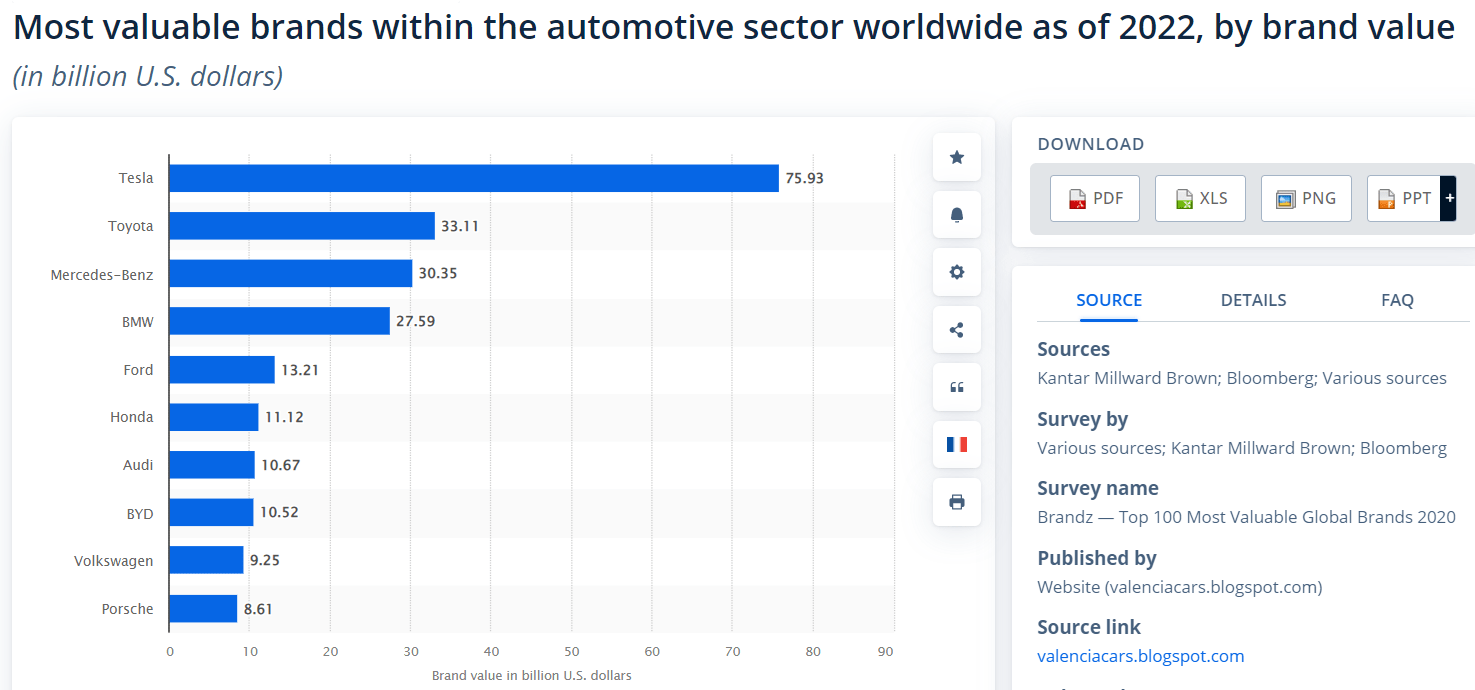 Statista
Statista
Tesla, Inc. (TSLA) is 20 years old and has managed to build the most valuable car brand on earth. In fact, its brand is worth more than Toyota (TM), Mercedes (OTCPK:MBGAF), and Ford (F) combined.
I have very little doubt that the Apple car could, within a few years, have a brand more valuable than everyone other than Tesla. And if it does a great job of design and convenience, Apple might become Earth’s most valuable car brand.
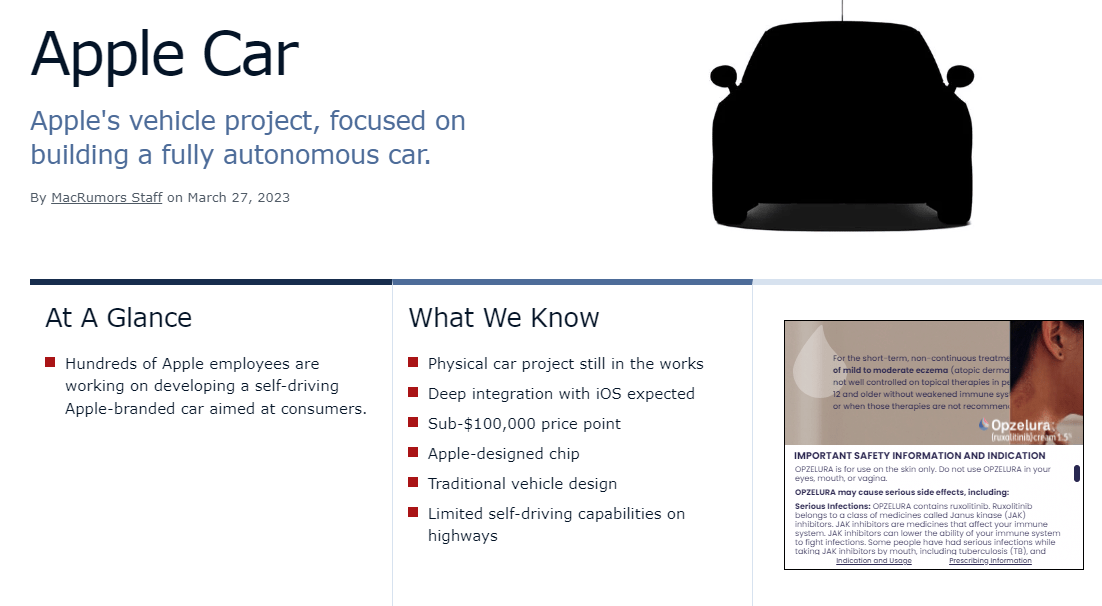 MacRumors
MacRumors
Apple is targeting the upper end of the market just like Tesla started out doing.
The Apple Car has been described as Apple’s “next star product” with Apple able to offer “better integration of hardware, software and services” than potential competitors in the automotive market. The Apple Car is likely to be marketed as a high-end vehicle rather than a standard electric vehicle, but Apple is aiming for a price point under $100,000.” -Apple.
Where Tesla perfected the electric vehicle (“EV”) and made electric cars the new hotness, Apple plans to take it to another level by turning rolling supercomputers into rolling Apple supercomputers, with full integration with the Apple ecosystem.
Apple is considering partnering with Hyundai or Nissan for the manufacturing to ramp up quickly to try to topple Tesla as the king of cool aspirational luxury cars.
In December 2020, Apple hired Manfred Harrer, a Porsche executive with expertise in chassis design. Harrer was considered one of the best engineers in the Volkswagen Group, serving as the head of chassis development at Porsche prior to overseeing the Cayenne product line.
A former top Volkswagen manager told Business Insider that Mr. Harrer was a “hidden champion,” and the “measure of all things in his field.” Prior to working on chassis development at Porsche, Harrer worked for BMW and Audi.- MacRumors
Apple is hiring top engineers from Porsche and BMW.
Apple, in June 2021, hired former BMW senior executive and self-driving vehicle startup founder Ulrich Kranz for its car project. Kranz founded Canoo, a self-driving car startup he left earlier this year. Before creating Canoo, Kranz helped develop the i3 and i8 vehicles at BMW, where he was employed for 30 years.” – MacRumors.
Apple has also poached top engineers and designed from Mercedes and Ford.
What kind of designs might we expect from an Apple Car?
Here is what Dall-E, open AI’s image creation software, thinks the Apple car might look like.
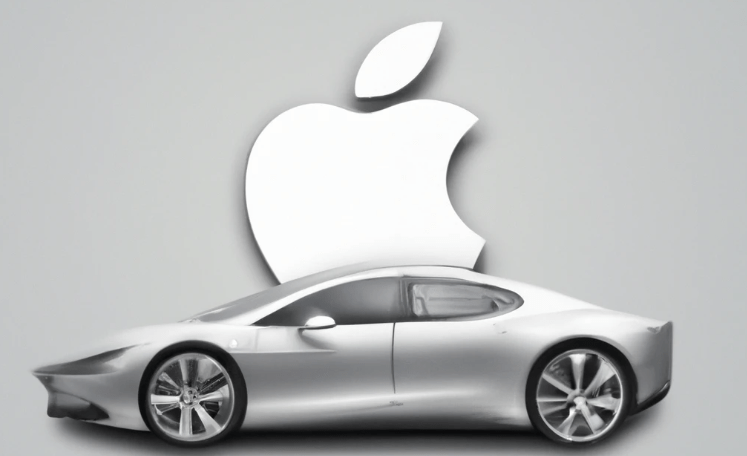
Dall-E
What kind of sales potential would an Apple Car potentially have? Let’s consider the expected sales of Tesla, today’s king of cool cars, and what young people aspire to drive.
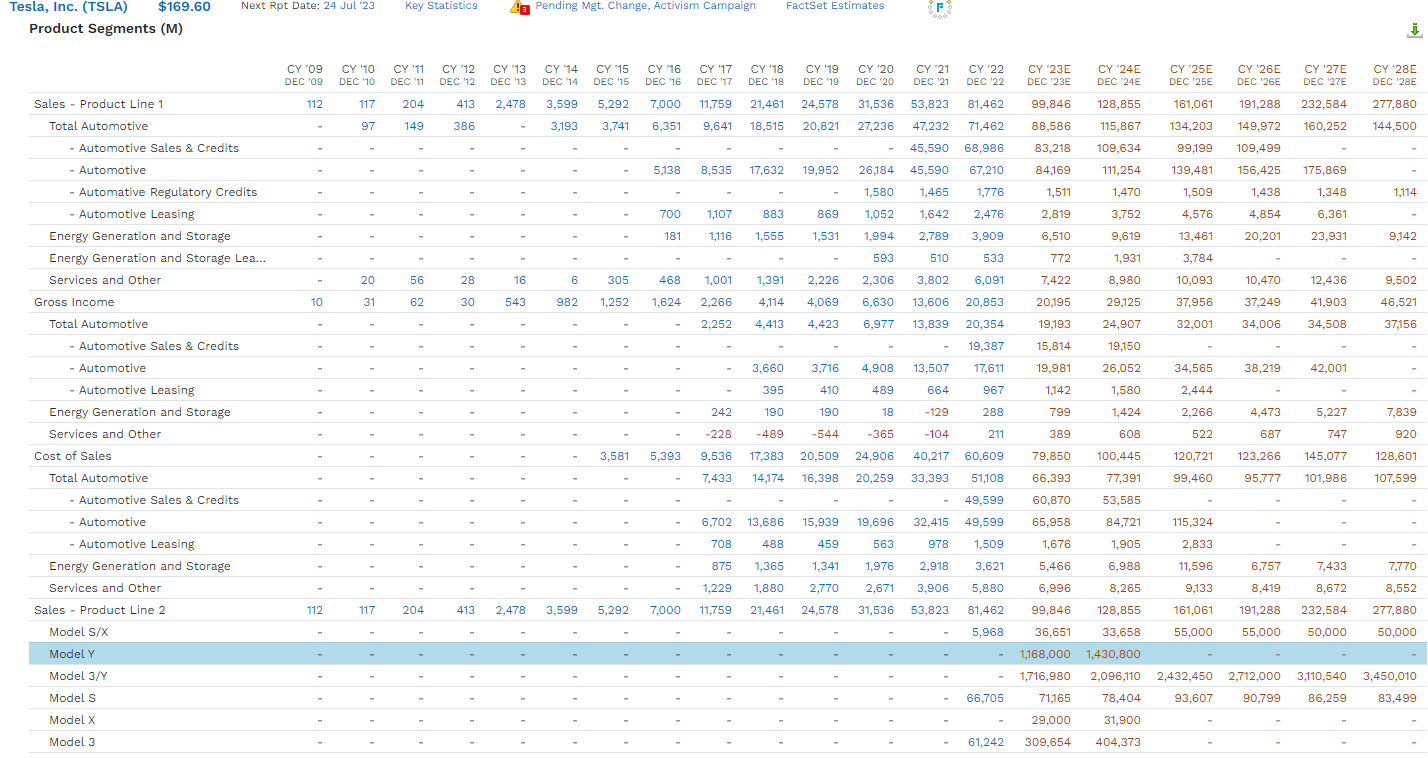 FactSet Research Terminal
FactSet Research Terminal
Tesla is expected to sell $278 billion in 2028.
What about Apple?
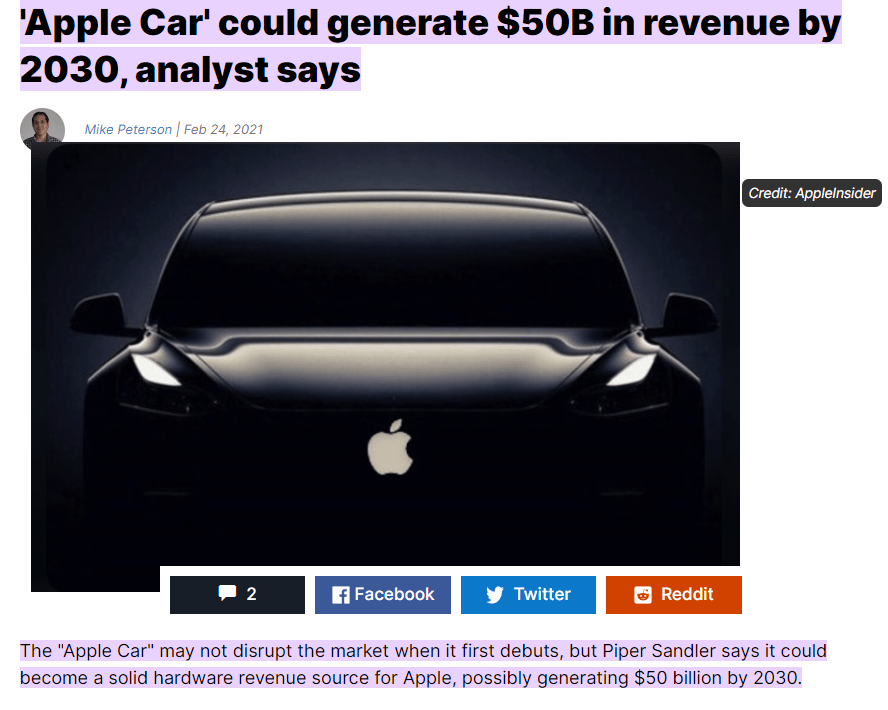 Apple Insider
Apple Insider
At the rate Tesla is growing, by 2030, it could be selling $400 billion worth of cars.
Is the $50 billion per year in Apple cars from Piper Sandler outrageous? I would say, given Apple’s track record of quickly becoming #1 or #2 in its industry, it might be conservative. In fact, Piper Sandler is modeling 1% market share for Apple by 2030.
I wouldn’t be surprised if Apple eventually achieves 50% to 150% of Tesla’s sales.
It will take time to ramp up production. But I think the demand will be there for the Apple faithful to eventually make Apple the #1 or #2 automaker on earth.
Ok, so maybe Apple Car is an exciting and sexy chance for Apple to take its brand to a whole new level. But car makers aren’t exactly known for making money.
What kind of cash flow can a luxury EV make for Apple?
FactSet Research Terminal
In 2028 Tesla is expected to grow its free cash flow from $12 billion to $24 billion.
How does that compare to its biggest peers?
- Tesla’s free cash flow: $23.6 billion
- VW (OTCPK:VWAGY): $12.9 billion
- Stellantis (STLA, old Chrysler): $12.3 billion
- Toyota: $7.7 billion
- General Motors (GM): $6.6 billion
- Ford: $3.4 billion.
What about Apple? If Apple eventually gains the same manufacturing capacity and margins, what would $24 billion in free cash flow mean for it?

FactSet Research Terminal
$24 billion in free cash flow per year would be a meaningful boost to Apple’s $100 billion per year. And eventually, that might grow into $50 or even $100 billion.
But wait a minute, if it takes Apple 20 years to generate $50 or even $100 billion in free cash flow, would that not really boost the growth rate much?
After all, even doubling Apple’s free cash flow from $100 billion today to $200 billion via Apple car is only a 3.5% annual growth boost if it takes 20 years.
The Hidden Genius Of Apple’s Aspirational Luxury Brand
Apple started out with cool computer, the iMac, pioneered by Steve Jobs upon his return to the company he co-founded.
Unlike all other PCs that commanded 90% of the market share, he built the Apple brand around being different.
Then he perfected the MP3 player with the iPod and dominated that industry through sheer coolness.
Then the iPhone wiped out Nokia and BlackBerry within a few years by being so much better and cooler.
Then tablets, then smartwatches, and now smart speakers.
Next up, electric luxury cars.
What’s after cars? I don’t know, but if I were to guess, I would say Apple Homes.
The Potential $1 Million Apple Home

Dall-E

Dall-E
Why have I never been more excited about Apple and the $6200 position my family hedge fund owns?
- the plan is to take that to $33,000 by the end of the year via exchange-traded funds, or ETFs.
Let me put it this way. What is the #1 fear any company has? Losing its moat.
What is the #1 thing that cool brands like Tesla or Apple have? Losing their “cool” status.
What brands are timeless and seldom worry about losing their moats or aspirational status?
- Yves Saint Laurent was founded in 1961 (62 years old)
- Christian Dior was founded in 1946 (76 years old)
- Fendi 1925 (98 years old)
- Gucci 1921 (102 years old)
- Balenciaga 1919 (104 years old)
- Prada 1913 (110)
- Chanel 1910 (113 years old)
- Rolex 1905 (118 years old)
- Tiffany 1837 (136 years old)
- Burberry 1857 (166 years old)
- Louis Vuitton 1854 (169 years old)
- Hermes 1836 (186 years old)
- Château d’Yquem (oldest LVMH brand) 1593 (430 years old) – $240 to $3000 bottles of wine.
Luxury brands are timeless! They don’t just last for years or decades, they can last for centuries.
That’s what Apple is striving for and succeeding at right now.
The kids who grew up being rebels with iMacs and then trendsetters with iPhones are now growing up and making a lot of money.
They know Apple, love Apple and trust Apple with their savings accounts!
And now Apple is coming out with the ultimate status symbol, a sporty sexy car. There is nothing more American than that and nothing more aspirational…other than a luxury home.
From home speakers all the way up to luxury EVs and possibly one day million-dollar fully integrated Apple Homes, the Apple luxury brand is alive and well.
That’s what Warren Buffett loves about Apple. Not that it’s a cash-minting machine today, but that it looks like it has a good chance to remaining so as an aspirational luxury brand for decades or even centuries to come.
Bottom Line: Buffett Loves Apple Because It Just Proved It’s The LVMH Of Tech
Am I saying that Apple is a great buy today? Nope.
- quality rating: 100% medium-risk 13/13 Ultra SWAN
- dividend safety: 100% (1.10% severe recession dividend cut risk)
- fair value:$160.98
- current price: $173.09
- Discount: -8%
- DK rating: hold
- Yield: 0.6%
- Long-term growth consensus: 9.8%
- Long-term total return potential: 10.4% vs 10.2% S&P.
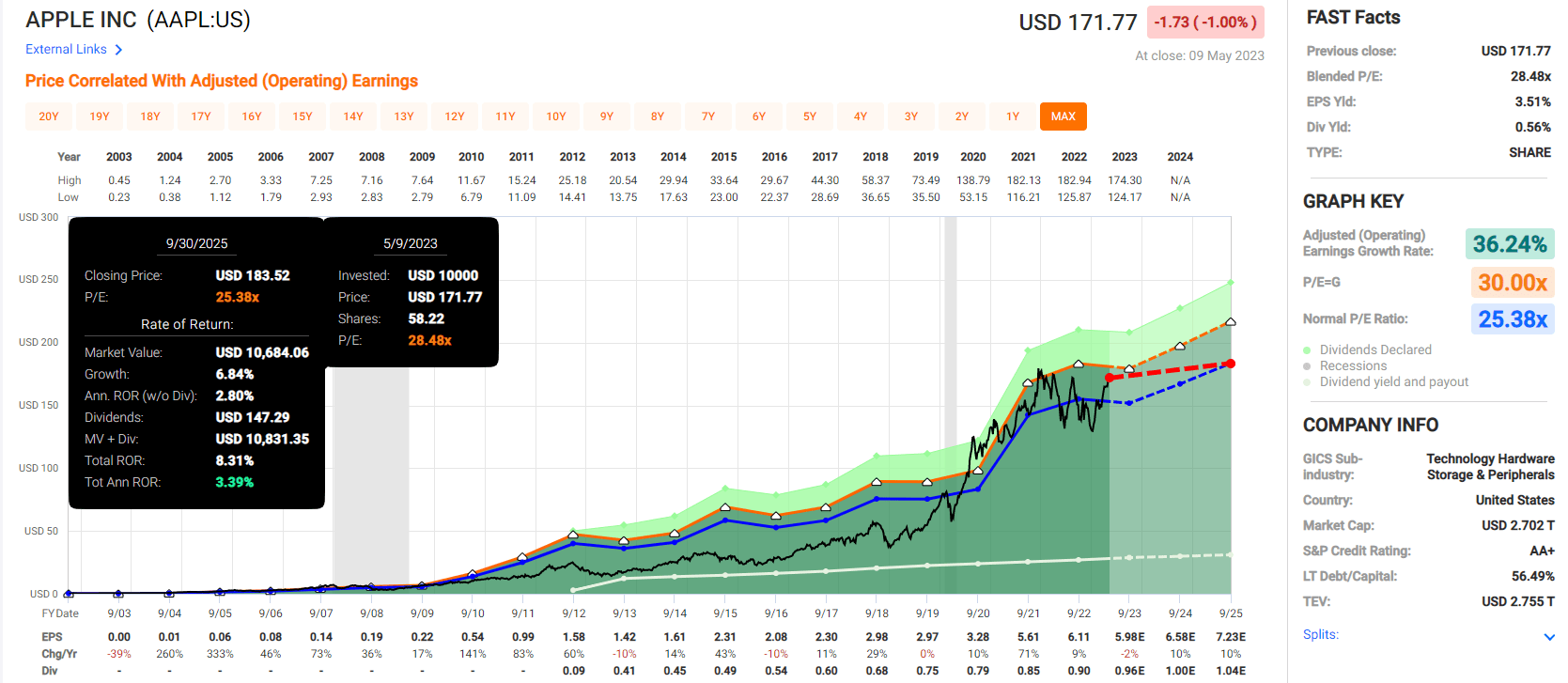
FAST Graphs, FactSet
Is Apple a fast-growing company? Nope, 9.8% long-term growth expected.
Is it undervalued? Probably not, given that it’s above its historical fair value of 25.4X earnings.
But isn’t Apple the LVMH of tech? Yes, I just spent the last 2500 words proving that.
So maybe Apple should be worth 30X earnings? 35X?

FactSet Research Terminal
LVMH is growing at an identical rate as Apple, 10%.
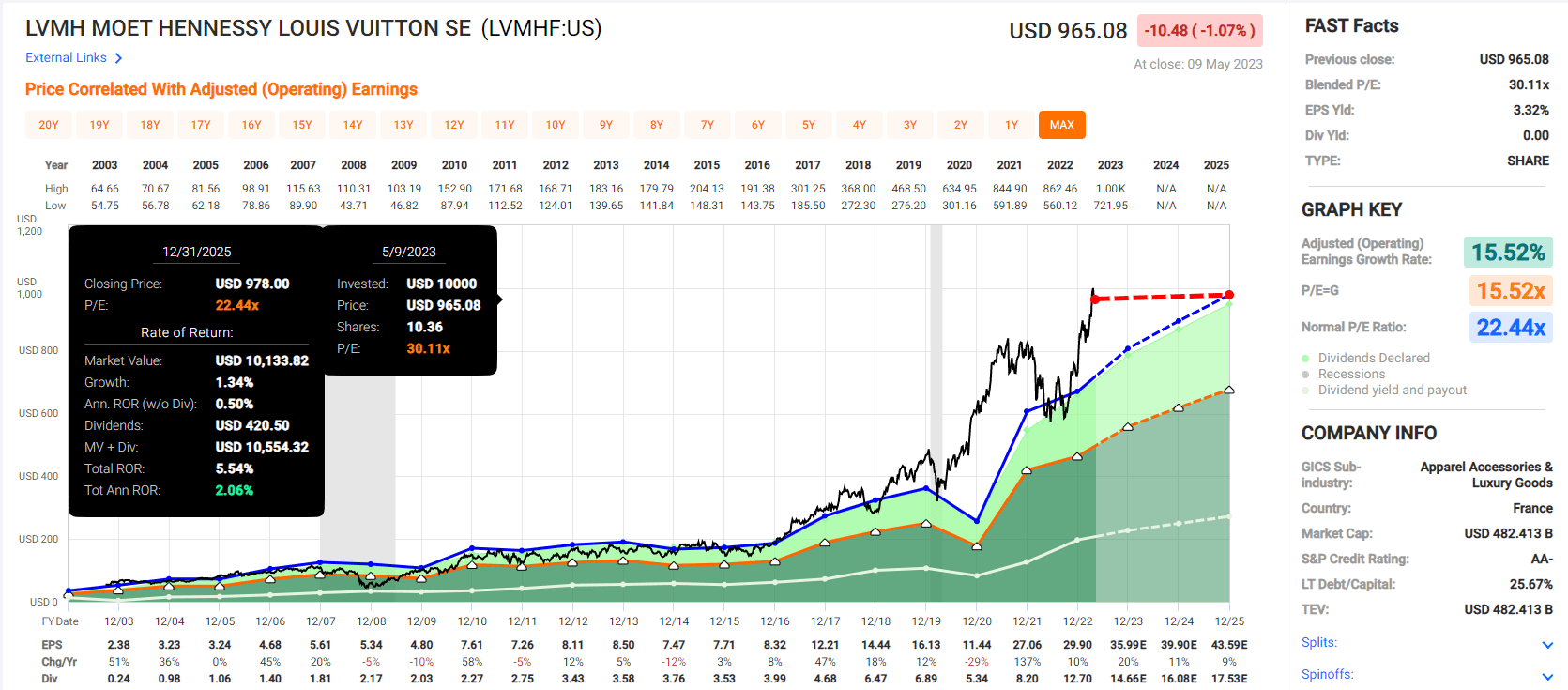
FAST Graphs, FactSet
LVMH’s historical fair value is 22.4X earnings, as you can see based on the average PE of the last 20 years.
LVMH’s cash-adjusted earnings are 15X vs. a historical 12.8.
Apple’s cash-adjusted PE is 21.8. Reasonable, perhaps, but it’s more speculative than I can get to say it’s a reasonable buy today.
But the point is that there is a reason that Apple is the world’s favorite company, and Buffett’s.
With its latest $1 billion wins, $1 billion in deposits in 4 days for high-yield savings, and $1 billion in AirPods Pro 2 sales in 8 days, Apple has proven it’s not a tech company; it’s the king of aspirational luxury tech brands.
Exactly the kind of world-beater brands that can keep growing at around 9% to 11% for decades, or even centuries, and deliver life-changing income and wealth.
Not just for you but your children, grandchildren, and great-grandchildren.
As someone who is interested in a philanthropic trust and donating billions to charity over time, a wide-moat business that can endure and thrive for centuries is very appealing.
And that’s why Apple is also my favorite company, though I plan to own a 2% stake in my family hedge fund via ETFs.
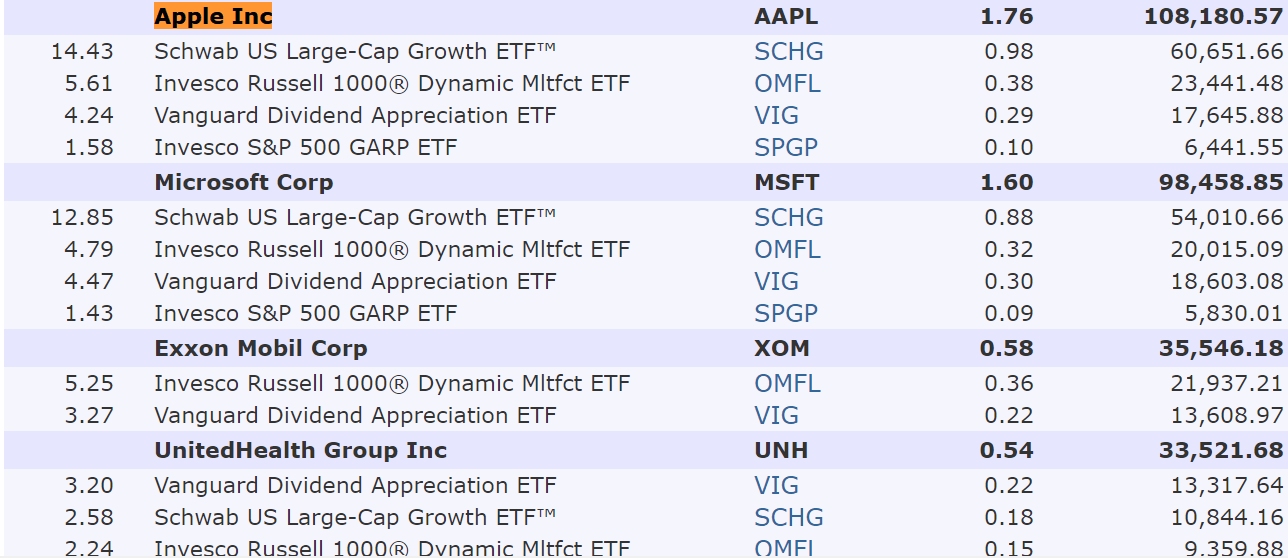
Dollar Amount Not To Scale (Morningstar )
Given the debt ceiling crisis could cause a 45% plunge in the market and the recession likely starting in 6 weeks, I wouldn’t advise anyone to pay 28X earnings for Apple right now.
You won’t lose money long-term. I can say that with 99.71% certainty.
- AA+ credit rating = 0.29% 30-year bankruptcy risk.
But a better valuation and higher margin of safety is likely coming because not even mighty Apple is likely immune from a recession.
But if you have owned it for years? Like Buffett and are sitting on giant gains? Don’t pay taxes on those unrealized profits because Apple is going to sail through this recession and come out stronger than ever on the other side.
How confident am I? As much as you can be about any company’s long-term growth prospects, 80%, the Marks/Templeton certainty limit, signifying “I’ll die on this hill” confidence.
If you own Apple Inc. stock today, hold, and you and I can toast our success and ownership in the world’s greatest company in 50 years.
In our Apple luxury home, which we were driven to in our autonomous Apple Car while utilizing the AI-powered by our iPhone ;).
Editor’s Note: This article discusses one or more securities that do not trade on a major U.S. exchange. Please be aware of the risks associated with these stocks.
Seeking Alpha’s Disclosure: Past performance is no guarantee of future results. No recommendation or advice is being given as to whether any investment is suitable for a particular investor. Any views or opinions expressed above may not reflect those of Seeking Alpha as a whole. Seeking Alpha is not a licensed securities dealer, broker or US investment adviser or investment bank. Our analysts are third party authors that include both professional investors and individual investors who may not be licensed or certified by any institute or regulatory body.
BNP Paribas Ends Financing for New Oil and Gas Projects
Mark Segal May 11, 2023
Paris-based global bank BNP Paribas announced today that it will end its direct financing for new oil and gas fields, strengthening its policy – released earlier this year – to reduce its fossil fuel financing activity.
The move makes BNP Paribas the second largest global bank to commit to exiting new oil and gas project financing, after HSBC unveiled a similar policy in December 2022. Responsible investing NGO ShareAction, which has been engaging with the firm over its fossil fuel financing activities said that the announcement will pressure the banks’ major European peers to follow suit.
Kelly Shields, Project and Campaign Manager at ShareAction, said:
“Now Societe Generale, Crédit Agricole, Barclays and Deutsche Bank are firmly in spotlight as the remaining top financiers of oil & gas expansion in Europe that have still to make a commitment to cease financing for new oil and gas fields. Investors will continue to hold these banks’ feet to the fire to ensure they enact policies that align with a 1.5C pathway and protect people and planet for future generations.”
BNP Paribas released a series of new energy financing policies in January 2023, including commitments to reduce financing for oil extraction and production by more than 80% and for gas extraction and production by over 30% by 2030, and to transition 80% of its energy financing activities to the production of low carbon energies by that date as well.
The bank came under significant pressure following the release of the new policy, however, as it left the door open for continued financing of new oil and gas projects. BNP Paribas was among a group of large European banks targeted in a campaign led by ShareAction and including investors representing more than $1.5 trillion in assets, calling for commitments to end financing for new oil and gas fields this year, and the bank was also sued by a group of French NGOs in February over its financing for new oil and gas projects.
The updated policy released today retains the 80% and 30% financing reduction targets for oil and gas, respectively, but includes commitments to “no longer provide any financing dedicated to the development of new oil and gas fields regardless of the financing methods.”
BNP Paribas’ 2023 Climate Report, released today, also includes a series of 2030 interim decarbonization targets for financing carbon-intensive sectors, including commitments to a 25% emission intensity reduction for the steel sector, 10% emissions intensity reduction for aluminum, and a 24% emissions intensity reduction for cement. The bank set targets for the oil and gas, power generation and automotive sectors last year.
ShareAction applauded the bank’s updated policy but said that it will continue to engage with BNP Paribas over gaps in the policy that would enable “indirectly financing new oil and gas activities.”
Shields said:
“Following months of engagement with investors and ShareAction, BNP Paribas has improved its oil and gas policy at least in part. Its new commitments are welcome and suggest that banks’ financing appetite for new oil and gas is rapidly drying up. That said, BNP Paribas still has a way to go before meeting the climate standards expected of them by investors and the public.”
I hope you have enjoyed this week’s read. Have a great week.
Regards,
Head, Fixed Interest and Superannuation
JMP Securities
Level 1, Harbourside West, Stanley Esplanade
Port Moresby, Papua New Guinea
Mobile (PNG):+675 72319913
Mobile (Int): +61 414529814